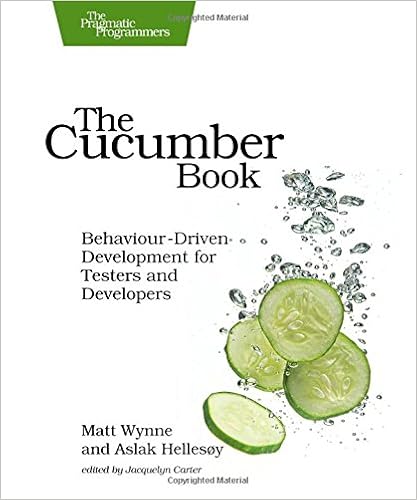 Cucumber book es una referencia para todos aquellos que quieren comenzar a automatizar o están automatizando con esta herramienta. Este libro les será de mucha utilidad puesto que tiene el alcance que actualmente se esta necesitando conocer para aprovechar al máximo sus funcionalidades.
Cucumber book es una referencia para todos aquellos que quieren comenzar a automatizar o están automatizando con esta herramienta. Este libro les será de mucha utilidad puesto que tiene el alcance que actualmente se esta necesitando conocer para aprovechar al máximo sus funcionalidades.
Matt Wynne y Aslak Hellesøy muestran cómo expresar las ideas de los clientes (a veces no tan sencillas de comprender ni transmitir) como un conjunto de especificaciones claras y ejecutables para que todos los miembros de un equipo las puedan leer y entender.
A pesar de haber nacido desde la comunidad Ruby, Cucumber se puede utilizar para probar casi cualquier sistema, desde un simple script shell o script Perl, hasta aplicaciones web escritas en PHP, Java o cualquier plataforma.
En la Parte 1, se presentan las características principales de Cucumber y de Cucumber Gherkin DSL para describir -en lenguaje sencillo- el comportamiento que los clientes desean que tenga el sistema, pudiendo escribir un código Ruby que interprete esas especificaciones en lenguaje fácil de escribir/entender y así comprobarlas contra la aplicación. Para todos aquellos que se inician con Cucumber, esta parte del libro enseña todo lo que se necesita saber para empezar.
En la Parte 2, se consolida el conocimiento adquirido con un ejemplo, donde se aprenden técnicas más avanzadas de Cucumber. También se aprende a probar sistemas y sistemas asíncronos que utilizan una base de datos.
En la Parte 3, se encuentran una selección de recetas para algunas de las situaciones más difíciles y comúnmente vistas por los autores. Con estos patrones y técnicas, se podrá aprender cómo probar aplicaciones web con Capybara y Selenium, servicios web REST, aplicaciones Ruby on Rails, aplicaciones heredadas y más.
The Cucumber Book es una guía autorizada que te dará a tí y a tu equipo, el conocimiento que necesitas para empezar a usar Cucumber con confianza.
Qué necesitas: Windows, Mac OS X (con XCode) o Linux Ruby 1.9.2 , de mínima.
Contenido del libro
I. Cucumber Fundamentals
1. Why Cucumber?
Automated Acceptance Tests
Behaviour-Driven Development
Living Documentation
How Cucumber Works
What we just learned
2. First Taste
Understanding our goal
Creating a feature
Creating step definitions
Implementing our first step definition
Running out program
Changing formatters
Adding an assertion
Making it pass
What we just learned
3.Gherkin basics
What’s Gherkin for?
Format and syntax
Feature
Scenario
Comments
Spoken languages
What we just learned
4. Step definitions: from the outside
Steps and step definitions
Capturing arguments
Multiple Captures
Flexibility
Returning results
What we just learned
5. Expressive Scenarios
Background
Data tables
Scenario outline
Nesting steps
Doc strings
Staying organized with tags and subfolders
what we just learned
6. When Cucumbers go bad
Feeling the pain
Working together
Caring for your tests
Stop the line and defect prevention
What we just learned
II. A worked example
7. Step definitions: on the inside
Sketching out the domain model
Removing duplication with transforms
Adding custom helper methods to the world
organizing the code
What we just learned
8. Support code
Fixing the bug
Bootstrapping the user interface
Making the switch
Using hooks
Building the user interface
What we just learned
9. Dealing with message queues and asynchronous components
Our new asynchronous architecture
How to synchronize
Implementing the new architecture
Fixing the flickering scenario
What we just learned
10. Databases
Introducing activerecord
Refactoring to use a database
Reading and writing to the database
Cleaning the database with transactions
Cleaning the database with truncation
What we just learned
III. Cucumber applied
11. The Cucumber command-line interface
Cucumber’s command-line options
Running a subset of scenarios
Changing Cucumber’s output
Specifying the location of step definitions
Managing your work in progress (WIP)
Using profiles
Running Cucumber from rake
Running Cucumber in Continous Integration
What we just learned
12. Testing a REST Web Service
In-Process Testing of Rack-Based REST APIs
Out-of-Process Testing of Any REST API
What we just learned
13. Adding tests to a legacy application
Characterization tests
Squashing bugs
Adding new behavior
Code coverage
What we just learned
14. Bootstrapping rails
Running the generators
Creating a user
Posting a message
Associating a message with a user
Creating a controller by hand
Implementing the view
What we just learned
Try this
15. Using Capybara to test ajax web applications
Implementing a simple search without ajax
Searching with ajax
The Capybara API
Taking screenshots
What we just learned
16. Testing command-line applications
with Aruba
Simple interfaces
Our first Aruba feature
Working with files and executables
Interacting with user input
Using Aruba’s Ruby DSL
What we just learned
A sections
A1. Using Cucumber with other platforms
A2. Installing Cucumber
Installing Ruby
HTTP Proxy Settings
Installing Bundler, Cucumber (and RSpec), other Gems
Choosing a text editor
A3. Ruby Gem Versions
A4. Bibliography
Wiki
Tutoriales y publicaciones relacionadas
Curso Online Automatización
[ acceso a la página del curso ]
